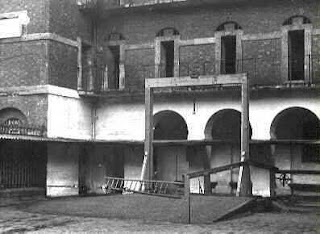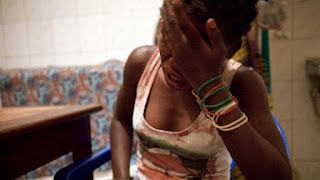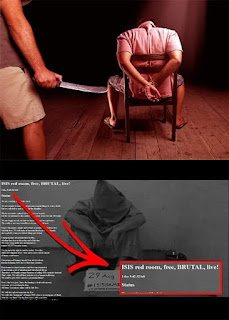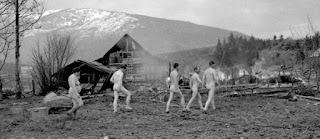Hang 'Em High - 1874 Triple Hanging at H.M. Prison Gloucester.
Not all hangings took place in Bristol, H.M. Prison Gloucester was where many executions took place, it's history is far older than Bristol.
Hang 'Em High - 1874 Triple Hanging at H.M. Prison Gloucester.
Executions of Edwin Bailey aged 32 Charles Edward Butt aged 22 Anne Berry aged 31.
H.M. Prison Gloucester Monday 12th January 1874 - Hanged by Robert Anderson Evans.
Bailey was the manager of a shoe shop in the Clifton area of Bristol, whose wife had left him due to his adultery.
In the summer of 1872, he seduced one of his customers, a servant girl named May Jenkins, and when in January 1873 she gave birth to a child, she took a summons out against Bailey after he refused to admit to being the father and to pay any maintenance. The court ordered him to pay five shillings per week for the child, which he sent to a police officer at Horfield.
Ann Berry worked for Bailey and was much enamoured by him; they began an affair while her husband was serving a prison sentence. She paid May Jenkins a visit and persuaded her to accept a health tonic for the baby. When the child began teething, the young mother administered the medicine. It contained a lethal dose of arsenic. Bailey & Berry were caught, convicted and hanged, together. At the time of their executions, Ann Berry's husband was still in Gloucester Prision for petty theft.
Charles Edwin Butt and Miss Phipps were neighbours in the village of Arlingham he paid his addresses to her.
On Sunday, August 17th they quarrelled becaused she refused to accompany him to Gloucester Cheese Fair on the Monday and had promised to accompany someone else. Stung by jealousy, he fetched his gun from home and shot the unhappy young lady, causing her instant death. He escaped but was subsequently arrested in Abergavenny.
For the triple hanging of Edward Butt, Mary Ann Barry and Edwin Bailey in 1874, Robert Anderson, the hangman, asked for a pit to be dug to allow the gallows platform to be level with the yard It is thought that this arrangement persisted until 1912.
Last Monday morning at eight o’clock, Charles Edward Butt, Edwin Bailey and Anne Berry underwent the last dread sentence of the law the former for shooting Miss Amelia Phipps: the last two named for poisoning an illigitimate child of which Bailey was adjudged to be the father. Charles Edwin Butt and Miss Phipps were neighbours in the village of Arlingham he paid his addresses to her.
On Sunday, August 17th they quarrelled becaused she refused to accompany him to Gloucester Cheese Fair on the Monday and had promised to accompany someone else. Stung by jealousy, he fetched his gun from home and shot the unhappy young lady, causing her instant death. He escaped but was subsequently arrested in Abergavenny.
The circumstances under which Bailey and Berry were convicted were thus stated with remarkable lucidity and conciseness by Judge Archibald to the Grand Jury at the recent Assizes — ‘Edwin Bailey and Anne Berry are accused of causing the death of Sarah Jenkins by poison — or rather I ought to tell you the prisoner Bailey has been committed as the principal in the offence and Anne Berry as an accessory before the fact.’
The deceased Sarah Jenkins was the illigitimate child of Mary Susan Jenkins and the prisoner Edwin Bailey was the putative father; an affiliation order had been made upon him in which he was required to pay five shillings each week. The other prisoner, Anne Berry, was in Bailey’s employment and had sought the acquaintance of the mother and grandmother of the deceased child from just after Christmas up until just before the child’s death. She was a regular visitor to the house.
She manifested considerable interest in the child, asking at different times to be allowed to take it out. A few days before the child’s death she recommended to the grandmother to give it some 'Steedman’s Soothing Powder' which would be received through the post from a charitable society known as the Dorcus Society.
On the 14th August a letter was received containing three powders marked 'Steedman’s Soothing Powder'. After the powders had arrived Anne Berry called again and was anxious to know if the powder had been received and if any had been given to the child.
She also told them she had moved somewhere else and would not be able to come again. On the 17th August, the child having some ailment (teething I suppose), the grandmother and mother in perfect good faith gave one of the powders to the child and in ten minutes afterwards it died, manifesting all the symptoms of poisoning with strychnine, and upon examination of the other two powders they also contained strychnine.
Now the guilt ot innocence of the prisoners depends on the circumstance and history of these powders and the mode in which they were conveyed to the house to be given to the child.
Suspicion fell on Anne Berry who was arrested and shortly afterwards Edwin Bailey was also arrested.
The letter in which the powders came purported to come from a lady named Jane Isabella Smith and it contained this inside:— ‘From the lady visitor of the 'Cotham Dorcas Society', we will send a few things for the child to wear in a day or two, Jane Isabella Smith, Hope Cottage, Cotham.’ On enquiry it turned out there was no such house or person but on the arrest of Edwin Bailey several letters were produced clearly in his handwriting which compared with the note and address in which the powders arrived.
There is further evidence in the depositions that the paper and envelope used were ones that Bailey was in the habit of using. The Jury, while giving a verdict of guilty, recommended that Berry and Bailey be given mercy.
THE EXECUTION
Petitions on behalf of Bailey, Berry and Butt received much support for commutation of sentence but to no avail; the sentences of death stood. On Sunday, the day before the hanging, a mob of some three or four hundred well-dressed people assembled at the railway station in the hope of catching a glimpse of the veteran hangman Calcraft, (or, as he was termed, 'Old Cal' ), who was expected at 3.30 pm from London.
This luxury was to be denied the mob for Calcraft, who is nearing the verge of that bourne whence no traveller returns, is too unwell to perform the grim duties of his unenviable task and the person who was to be his deputy arrived in Gloucester on Friday. Mr. Anderson will now be the executioner, he is said to have been a medical student and that he acts as Calcraft’s deputy solely on account of the pleasure he derives from the performance of his duty. He hands his fee to Calcraft in consideration of being allowed to indulge his taste.
The morning of January 12th arrived — a murky and gloomy morning. The prisoners were pinioned separately in their cells and all submitted to the operation with a calm fortitude which rendered the duties of the executioner free from trouble.
About 50 strangers were assembled within the walls, including representatives of the press from Gloucester, Bristol, Birmingham and Cardiff and several tradesmen and medical men of the city.
The gallows were errected in one of the airing courts, the drop being level with it, and a pit was dug beneath. Anderson, the deputy hangman, appeared. He wore a thin black coat with velvet cuffs and facings and on his head was a black scull cap of rough material. Exactly at four minutes past eight o’clock it was observed that the dread procession was approaching.
First came Butt led by the hand of the Chaplain, who was repeating the opening lines of the burial service. The woman Berry, attired in a light print dress, next made her appearance led by the Matron, then followed Bailey with the Governor of the goal, Captain Wilson, Mr. Greene the Deputy Governor and Mr. Hicks the surgeon and several Warders.
The prisoners walked to the gallows where they knelt and said the Lord’s prayer, Berry’s utterances being louder and more fervent than those of her companions.
While parts of the burial service were being read by the Chaplain, the ropes were adjusted (with some hesitation in the case of the woman) and white caps were placed over the heads of the culprits, the woman Berry standing between Butt and Bailey. Barry several times exclaimed 'Goodbye, God bless you, Miss Marshall' (the Matron) and then she added to the executioner 'This is just what my dreams have told me I should come to'.
The Chaplain shook hands with all three as did the hangman who then retired to the corner of the gallows and drew the bolt sustaining the drop, and the bodies disappeared behind a black screen. Butt and Bailey died almost instantaneously, but Berry, being of fragile build, appeared to live about three minutes, and Anderson dispatched her by pressing the body down.
In a few minutes the reporters were invited into the Mess Room and informed by the Under Sheriff that the executioner wished him to state that his real name was Anderson, that he was a member of the medical profession and a man of independent property and that he had a 'monomania' for this sort of business.
The Under Sheriff also mentioned that Caicraft was 78 years of age and no longer able to perform the duties of his office and it was entirely Anderson’s suggestion that a pit was dug beneath the gallows, so as to avoid the painful necessity for the prisoners to ascend the steps of a raised scafold.
Anderson had also stated that he had not brought with him sufficient rope to hang three persons as he had expected a reprieve for Berry, so he had had a new rope made within the prison by Bamaby the messenger who was formerly on a naval training ship.
The inquest took place in the Board Room at 10 o’clock that same morning when the Governor of the prison gave evidence and formal identification. Captain H. K. Wilson stated: ‘Butt was brought into the County Prison on August 26th, 1873 and Bailey and Berry were received on October 3rd last, and they have ever since been confined in this gaol.
I was present at the last winter assize where they were severally indicted and convicted of murder and sentence of death was passed on them. That sentence has been carried into effect within the walls of this prison within twenty four hours last passed.’ Captain Wilson mentioned a curious coincidence that both the murders occurred on the same day August 17th, 1873.
Mr. T. Hicks, surgeon of the prison, said: ‘I have daily visited each of the prisoners in my official capacity from the time they were brought into the prison until the time they were hanged. They were severally hanged until they were dead in persuance of the sentence passed on them.
After the bodies had been viewed by the Jury they were at once interned in the yard in which the execution had taken place, quick lime being put into the coffins to hasten decomposition.
The sufferers were buried in their clothes.’... by Senior Officer White P.R.O.
Amelia Phipps, shot dead by Charles Edward Butt at Arlingham, buried 27 Aug 1873, Whiteshill.













Comments
Post a Comment